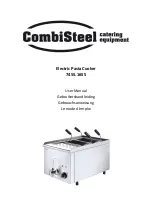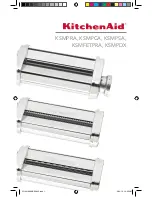
Xtreme Ice Training Manual
TP00952
October 17, 2005
52
The headmaster controls the operation when the condensing temperature drops below 70
°
F. The refriger-
ant charge is HP - 62 [R - 404A] and the headmaster dome charge setting is 200 PSI of nitrogen pres-
sure making it stable under the low temperature operating range down to - 20
°
F.
The normal flow pattern through the headmaster is from the condenser port to the receiver port. When
this flow pattern is unable to maintain a receiver outlet pressure equal to or above the dome pressure set-
ting of the valve, the dome pressure will force the valve portage to change closing the condenser port and
opening the bypass port from the compressor discharge line. This allows the high pressure vapor from
the discharge port to “buck” the receiver pressure back up. With the condenser port closed, the refriger-
ant is backed up in the condenser, basically reducing the condenser size, assisting in maintaining the dis-
charge portage flow and increasing the head pressure.
Remember, sense of touch to the lines of the headmaster will determine the flow path the headmaster is
in, condenser to receive, or bypass to receiver.
High side gauge installed at the receiver outlet valve will determine if the headmaster is functioning to
maintain the proper operating pressure.
In the event the control appears to be “stuck in bypass”, the pressure drop across the headmaster must
be measured. With a gauge installed at the receiver outlet valve and the high side service valve, the pres-
sure difference at these two points must be less than the 15 PSI. The three most common causes of an
excessive pressure drop are shortage of refrigerant, kinked remote lines, and excessive line length.
Eliminate refrigerant shortage first. Add refrigerant in two-pound increments
(not to exceed six pounds)
to determine if it corrects the pressure drop. If pressure drop is not corrected, inspect line set for sharp
bends or kinks and correct as required. If adding refrigerant does not correct continued (bypass) condition
and line set is not damaged, replace headmaster.
REMOTE SYSTEM EVACUATION/RE-CHARGE
All field repairs to the sealed system must start with a total discharge of the system following the require-
ments of the Clean Air Act of July, 1992.
Proper evacuation of the total remote system will require a three (3) point hook-up of your manifold and
hose set, (See Figure 30):
Point #1 - Cuber receiver outlet valve
Point #2 - Cuber high side service valve
Point #3 - Cuber low side service valve
Evacuation:
1. With cuber power supply turned “OFF” disconnect and insulate all 3 compressor leads at the com-
pressor. Turn power supply on, place power switch in the “on” position. This will energize (open) the
Liquid Line solenoid allowing evacuation of the Liquid Line between the solenoid and the expansion
valve(s).
2. Evacuate system to 200/250 microns or less. At this point, there should be a holding test of five(5)
minutes. You may expect a slight loss of vacuum as normal. A rapid rise to normal atmospheric
pressure indicates moisture still present in the system. On a “wet” system, it will prove beneficial to
use heat lamps to warm the compressor dome and evaporator surface during evacuation.
3. Turn cuber power switch OFF. Reconnect compressor leads.
4. *After proper evacuation hold test has been performed, the refrigerant charge should be “dumped”
into the receiver until the pressure equalizes, stopping the flow. Do not try to throttle the refrigerant
flow. Doing so will allow system pressure to balance too soon. The high-side service valve should be
closed and the balance of the charge fed slowly through the suction side service valve with the com-
pressor operational. Control the feed rate at no faster than four (4) ounces [113.g] per minute to en-
sure the compressor oil does not become too saturated with refrigerant resulting in a loss of com-
pressor lubrication.
5. All refrigerant re-charging must be weighed into the system, utilizing an electronic charging scale.
DO NOT
attempt to recharge the system by sight glass, system pressure, amperage, frost line or
sweat patterns.
Содержание XAC 1030 E50
Страница 2: ......
Страница 59: ...Xtreme Ice Training Manual TP00952 October 17 2005 54 THIS PAGE LEFT BLANK INTENTIONALLY...




































